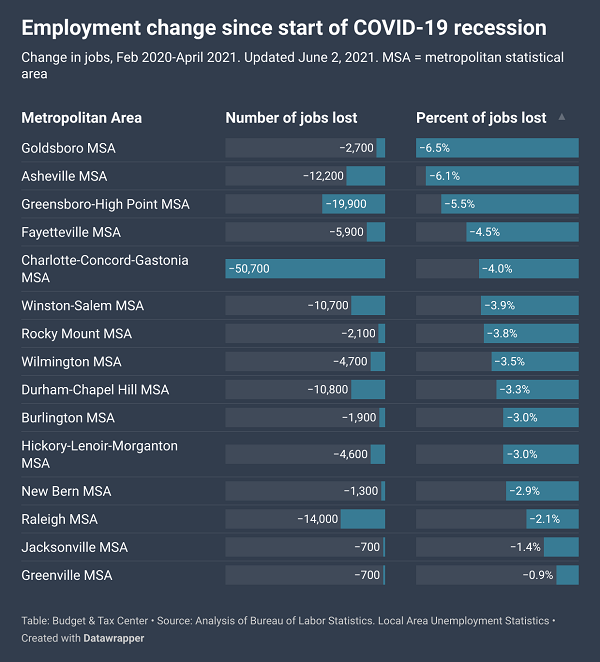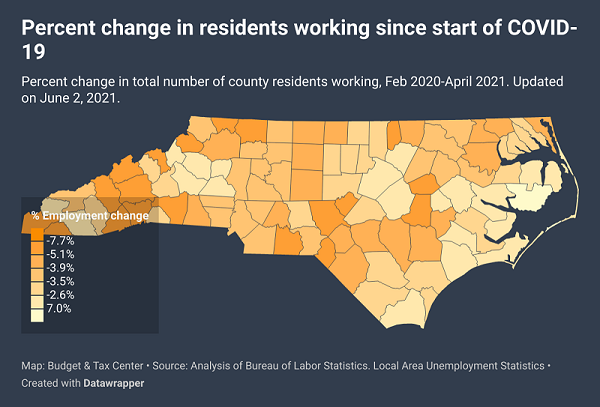Local labor market figures show an uneven recovery with many people still having difficulty finding work
RALEIGH (June 2, 2021) — Local labor market data for April released today show a recovery which is very much still a work in progress.
While businesses in some industries have struggled with hiring in recent weeks, many of the people who lost jobs due to the COVID-19 pandemic still can’t find work. Many of the people who were paid the lowest wages before COVID-19 suffered the worst employment losses and continue to need significant support to find new jobs.
“There are more people looking for work in most North Carolina communities than before COVID-19, so we need to really focus on knocking down the barriers keeping people from accessing jobs,” said Patrick McHugh, Research Manager with the North Carolina Budget & Tax Center. “Some of the challenges that businesses are having in finding employees are rooted in the financial barriers people face in getting back into the labor market, and a lot of people need supports like access to child care or training for the new jobs that are being created.”
County by county employment changes since beginning of COVID-19 Recession
County by county employment changes since beginning of Great Recession
Economic challenges facing North Carolina include:
- More people looking for work in nearly every North Carolina community: Businesses’ challenges in finding employees are not rooted in a lack of people wanting to work. Figures show more residents were trying to find work in April 2021 than before COVID-19 in 88 of 100 North Carolina counties, every major metropolitan area, and most smaller cities.
- Fewer people connected to the labor market in almost every community: The number of people working or looking for work is lower than it was before COVID-19 in all but three of North Carolina’s 100 counties. In addition to there not being enough jobs for everyone who wants to work, this fact shows a lot of North Carolinians face barriers in getting reemployed. These obstacles, which are often the most pronounced for women and people of color, threaten to create financial harm that could extend well beyond the end of the pandemic.
- Risk of deepening economic divides between largest cities and some other parts of the state: The recovery is further along in some of North Carolina’s largest metropolitan areas such as Charlotte and Raleigh, but many other parts of the state are still much farther from full recovery. Metropolitan areas that have experienced the worst declines compared to February 2020 include Goldsboro (-6.5%), Asheville (-6.1%), and Greensboro-High Point (-5.5%). By comparison, Raleigh is only (2.1%) below pre-COVID employment levels.

- COVID-19 has either erased all employment gains or deepened losses since the start of the Great Recession in a majority of counties: In North Carolina, 57 of 100 counties had fewer people working in April 2021 than before the Great Recession. Many parts of the state had never recovered all of the jobs that disappeared in the Great Recession, so the losses during COVID-19 are further compounding a long-term problem.

For charts showing the most recent labor data, including the context of COVID-19 effects, visit the Budget & Tax Center’s Labor Market page at www.ncjustice.org/labormarket.
For more context on the economic choices facing North Carolina, check out the Budget & Tax Center’s Prosperity Watch report.
The nonpartisan Budget & Tax Center is a project of the NC Justice Center, which works to eliminate poverty in North Carolina by ensuring every household in the state has access to the resources, services, and fair treatment it needs to achieve economic security.
 Justice Circle
Justice Circle